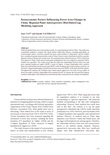Socioeconomic Factors Influencing Forest Area Changes in China: Regional Panel Autoregressive Distributed Lag Modeling Approach
Japan Agricultural Research Quarterly
| ISSN | 00213551 |
|---|---|
| NII recode ID (NCID) | AA0068709X |

Full text
jarq59-2_175-186.pdf1.48 MB
While the global forest area is decreasing overall, it is experiencing growth in China. This study uses econometric methods to analyze the causal factors behind this increase, focusing particularly on socioeconomic factors. Previous research has given scant attention to stationarity, and few studies have considered regional characteristics such as China’s forest resource distribution and the economic disparity between Inland and Coastal areas. We used panel data collected between 1993 to 2018 from four regions in China. Panel unit root and panel cointegration tests were employed, and panel ARDL models were specified. The results reveal that the long-term relationship between forest area and gross regional product per capita (GRPPC) varies by region. A linear relationship with a positive slope was realized between forest area and GRPPC in the Northeast and Central regions. However, an inverted U-shaped relationship is found between forest area and GRPPC in the East and West regions. Throughout the analysis, the Northeast and Central regions appeared to be in the recovery phase of forest area under a positive relationship with economic growth. In contrast, the East and West regions reached a stable phase with sufficient recovered forests and a constant level of economic development.
| Date of issued | |
|---|---|
| Creator | Jiaze TAN Satoshi TACHIBANA |
| Subject | economic analysis forest transition hypothesis panel cointegration test panel unit root test regional characteristics |
| Publisher | Japan International Research Center for Agricultural Sciences |
| Received Date | 2024-05-17 |
| Accepted Date | 2024-09-02 |
| Available Online | |
| Volume | 59 |
| Issue | 2 |
| spage | 175 |
| epage | 186 |
| DOI | 10.6090/jarq.24J05 |
| Language | eng |
